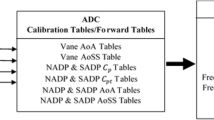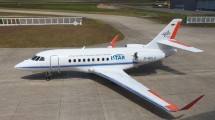Abstract
The installation error of the air data system is comprised of static pressure error and total pressure error. Two basic methods are used in flight test to determine the installation error of the air data system, namely pressure-based method and speed-based method. Total pressure error is usually small enough so that it can be neglected and won't cause significant errors. Sometimes, due to the position error of the pitot tube or the accuracy of the sensor, total pressure measured is different from the real total pressure, this difference can severely influence to the air data calibration result. This paper quantitative analysis the influence of total pressure error on the result of air data calibration, and put forward a solution to the air data calibration method in flight test.
Access provided by Autonomous University of Puebla. Download conference paper PDF
Similar content being viewed by others
Keywords
1 Introduction
Accurate air data is crucial to a safety flight. As modern aircraft evolve towards a more worry-free operating concept, flight control system, FADEC and other systems are increasingly relying on more accurate and more reliable air data. However, the measured air data always has a small error compared to the actual air data. Generally, the error of the air data consists of principle error, instrument error and installation error. Installation error is caused by variations in air-flow information at different positions of the fuselage, which can vary depending on various configurations (flaps, slats, L.G), Mach number, and angle of attack. In order to estimate the installation error, CFD method, wind tunnel method and flight test method are often used.
2 Air Data Measurement and Calibration Method
So far, civil transport aircraft still uses pitot-static tube to measure the total pressure, static pressure to obtain the airspeed and pressure altitude. The difference between total pressure and static pressure is called impact pressure (Eq. 1). The Mach number can be obtained using The Bernoulli equation or Rayleigh supersonic pitot-static equation (Eq. 2, Eq. 3), and pressure altitude can be obtained using standard atmosphere model.
The number γ in Eq. (2) is gas constant and a value of 1.4 can cover most situation in normal flight. Replace the static pressure and speed of sound as sea level parameters of standard atmosphere model in Eq. (2), (3) and (5), we can get indicated airspeed (IAS). If the impact pressure is calibrated, the indicated airspeed is called calibrated airspeed (CAS) as shown in Eq. (6) and (7). When at sea level of the standard atmosphere model, the calibrated airspeed (VC) is equal to the true airspeed (VT) and ground speed when there is no wind.
From Eq. (2), (3), (4), (6), (7), we can see the accurate IAS, Mach number and pressure altitude rely on accurate total pressure and static pressure. We already know these information are different when measured in different position of the fuselage, in order to calibrate the measured air data, flight test method is used to determine and verify this error.
There are many ways to determine air data error in flight test, for example: tower fly-by method, steady level flight using GPS [1], trailing cone method (Fig. 1), nose boom method (Fig. 2). These methods can be categorized into two types: speed-based method and pressure-based method. Speed-based method tries to obtain the real airspeed, using the real airspeed to obtain the real static pressure, and then the real IAS and pressure altitude can be obtained. The schematic diagram is shown in Fig. 3. Pressure based method tries to obtain the real static pressure, and the pressure altitude can be obtained. Assuming that there is no error in total pressure, we can get real IAS using total pressure and real static pressure. The schematic diagram is shown in Fig. 4. Nowadays, most transport aircraft use retractable trailling cone for air data calibration. For small aircraft, retractable trailling cone system cannot be installed into the aircraft due to the limitations in cabin and sometimes even a primitive trailing cone is hard to be installed, so speed-based method (level flight with GPS) is more commonly used in air data system calibration.
3 Total Pressure Error and Its Influence on Air Data System Calibration
A large number of wind tunnel tests and flight tests show that total pressure measured can be accurate [2, 3] in a large range of alpha angle and slide angle. However, sometimes the measured total pressure error can be quite significant, particularly during crosswind flight. Figure 5 shows the time history during the taxing of a transport airplane. It shows clearly the installation error of total pressure, the IAS difference from ADC1 and ADC2 during taxing was about 20 km/h to 30 km/h, but the static pressure difference between ADC1 and ADC2 was less than 10 Pa, the total pressure difference was about 140 Pa. Obviously, the IAS difference was caused by total pressure difference. After carefully checking, the total pressure of ADC1 was sourced from the left pitot tube and the total pressure of ADC2 was sourced from the right pitot tube. The schematic diagram of the air data system is shown in Fig. 6. However, almost all transport aircraft is designed this way, surely this is not the real reason that causes the difference on total pressure from two ADCs. Finally, we found that near the front of the two pitot tube was a small bulge of the porthole, the initial grid model for CFD simulation and scaled model for wind tunnel test were covered with smooth surface, so the installation error of total pressure was left until flight test. So, we increased the height of the foundation bed for pitot tube as shown in Fig. 7.
Another set of data is shown in Fig. 8. The IAS difference from the two ADCs was about 10 km/h when flown at 6200 ft height. The static pressure difference between the two ADCs was about 24 Pa (average) and the total pressure difference was about 130 Pa (average). In this case, the aircraft was a small normal type aircraft, one air data system was mounted ahead of the nose and the other air data system was mounted at the wing tip of the aircraft.
As can be concluded from the above examples, if the air data system is not designed properly, the total pressure is possible to be distorted. In these cases, traditional air data system calibration methods may lead to obvious mistakes. To be specific, using speed-based method could get accurate CAS but wrong pressure altitude; using pressure-based method could get accurate pressure altitude but wrong CAS.
4 Example Analysis
During previous chapters, total pressure error dose exists. Let’s analyze air data calibration in two cases. In the first case, if the static pressure from ADC was accurate, the IAS error was caused by total pressure error. Assume that the difference between the real air speed and IAS from ADC was just meet the upper limit or lower limit that FAR25.1323 (c) required: “the airspeed error of the installation, excluding the airspeed indicator instrument calibration error, may not exceed three percent of five knots, whichever is greater, throughout the speed range, from VMO to 1.23VSR, with flaps retracted, and 1.23VSR0 to VFE with flaps in the landing position”. Using speed-based method for air data calibration, we could get the reference pressure altitude and it may be wrong from the real pressure altitude. Table 1 shows the static pressure error and pressure altitude error using traditional speed-based method. Figure 9 shows the D value of pressure altitude along with different air speed. We can see that the deviation of reference pressure altitude could far more exceed the limit that FAR25.1325 requires for static pressure system since very low air speed. The FAR25.1325 (e) required: “Each system must be designed and installed so that the error in indicated pressure altitude, at sea level, with a standard atmosphere, excluding instrument calibration error, does not result in an error of more than ±30 ft per 100 knots speed for the appropriate configuration in the speed range between 1.23VSR0 with flaps extended and 1.7 VSR1 with flaps retracted, however, the error need not be less than ±30 ft”.
In the second case, if the total pressure error was the same as the error shown in Fig. 8 (130 Pa), using pressure-based method for air data calibration, we can get accurate pressure altitude for the static pressure was accurate, the reference IAS was different from the real IAS data. Table 2. Shows the error of IAS using pressure-based method for air data calibration when the total pressure measured is not correct. The black solid line in Fig. 10 shows the D-value of reference CAS and real CAS, the red dashed line shows the limit required by FAR25.1323 for airspeed indicating system, and the red solid line shows the calibration result for CAS using tradition pressure-based method. We can see the error in CAS exceeded the requirement of FAR25.1323 during almost the whole subsonic range, and the error gets larger when the airspeed gets lower.
5 Conclusion
We could see the total pressure error dose exists when using flight test method, in such situation, using traditional pressure-based air data calibration method (ignore the total pressure error) could get accurate pressure altitude, but the reference CAS could be deviated from the real CAS, and the smaller the airspeed, the larger the deviation. Using traditional speed-based air data calibration method (ignore the total pressure error) could get accurate CAS, but the reference pressure altitude could be errored considerably. Based on the analysis above, pressure-based air data calibration method (i.e. trailling cone method) was preferred if the system had a more accurate requirement on pressure altitude. In addition, in order to avoid the total pressure installation error, the position of pitot tube must be carefully selected. Additional pitot tubes also can be used to estimate the accuracy of total pressure.
References
Liu, H.Y., Liu, L., Cao, F.H.: Reference air data boom method for air data system calibrations. J. Exp. Fluid Mech. 27(2), 91–94 (2013)
Zhang, D.Y., Chen, P., Lu, X.R.: The calibration method for installation error of the air data system using GPS. Flight Dyn. 18(2), 62–66 (2000)
Xi, C., Cheng, T., Liu, J.: Research of a GPS-based airspeed calibration method under crosswind. Aeronaut. Sci. Technol. 26(05), 53–56 (2015)
Author information
Authors and Affiliations
Corresponding author
Editor information
Editors and Affiliations
Rights and permissions
Copyright information
© 2024 The Author(s), under exclusive license to Springer Nature Singapore Pte Ltd.
About this paper
Cite this paper
Xi, C. (2024). Analysis of the Influence of Total Pressure Error on Air Data Calibration. In: Jing, Z., Zhan, X. (eds) Proceedings of the International Conference on Aerospace System Science and Engineering 2023. ICASSE 2023. Lecture Notes in Electrical Engineering, vol 1153. Springer, Singapore. https://doi.org/10.1007/978-981-97-0550-4_15
Download citation
DOI: https://doi.org/10.1007/978-981-97-0550-4_15
Published:
Publisher Name: Springer, Singapore
Print ISBN: 978-981-97-0549-8
Online ISBN: 978-981-97-0550-4
eBook Packages: EngineeringEngineering (R0)














